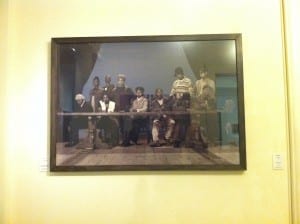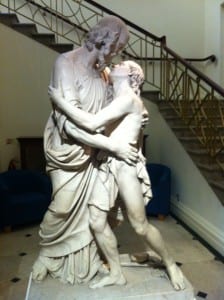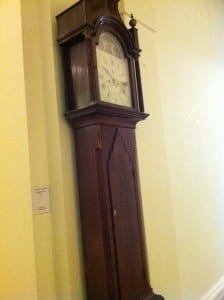After finding out our chosen site, we decided to visit The Collection as a member of the public to gain a firsthand understanding of the space. Whilst there, we explored the current ‘Past to Present’ exhibition and this inspired the beginnings of our ideas for possibly creating a piece focusing around the progression of time. A stand-out feature of this exhibition was the ‘Languages from the Past’ audio talk, which elaborated on different readings from Lincolnshire’s past. The use of headphones was a departure from the traditional museum experience. This ingenuity reminds us of the work of Janet Cardiff and inspired us towards the idea of incorporating audio and other sensory stimulants, moving our piece away from a purely visual field.
When exiting the exhibition, we noticed a faint whispering, only later to discover speakers integrated within the walls. We found this to be an interesting device to capture visitor’s attention without overpowering the rest of the exhibition.
The museum, however, was only half of our designated site so we ventured across to The Usher Gallery. This was an inspiring place with a number of contrasting exhibits; ranging from the classical statues of antiquity to a modern photographic interpretation of an African-American ‘Last Supper’.

‘The Last Supper’ by Faisal Abdu’Allah 2003
Incorporated in between these era’s, were representations of British arts featuring pastoral scenes. One particularly intriguing feature was the 1795 ‘Pineapple Dish’. The fact that something we consider as common and everyday as the pineapple was seen as exotic and important enough to have its own item of specific crockery, highlights how perspective can change over the passage of time.

L: ‘Pineapple Dish’ by William ‘Quaker’ Pegg 1795
The idea of time is something which was highlighted as the one constant throughout the Usher Gallery; almost every room featured some form of clock or timepiece. This triggered the idea of time as an abstract concept as opposed to something which we can attempt to define on the face of a clock. This led us to using the notion of time as a stimulus for our piece, focusing on the various perceptions of time such as: a historical epoch, something quantified by the use of watches and clocks, the aesthetics of both the inner and outer workings, and the way in which time can be used as a healer but equally recognized as a force of decay.
Authors: Chloe Doherty, James Barker, Shane Humberstone, Tabitha Hilton-Berry





Comments are closed.